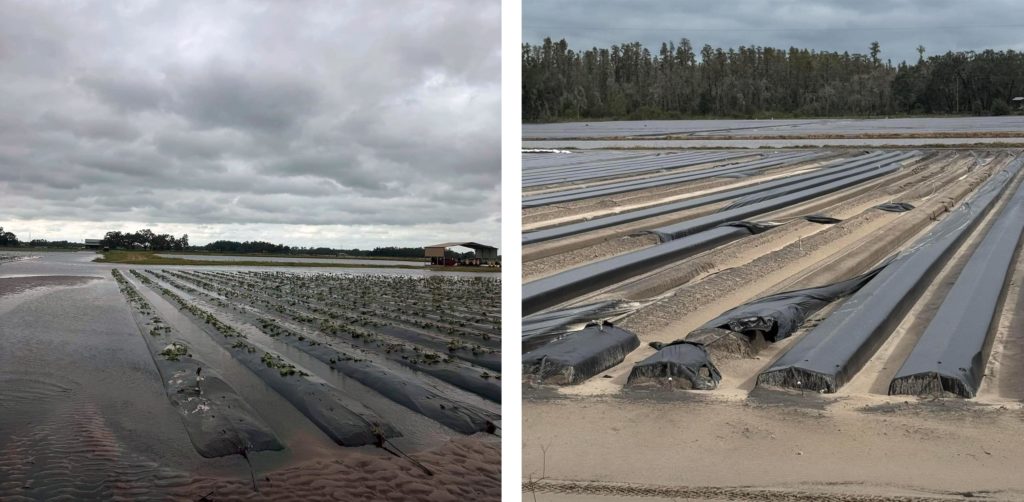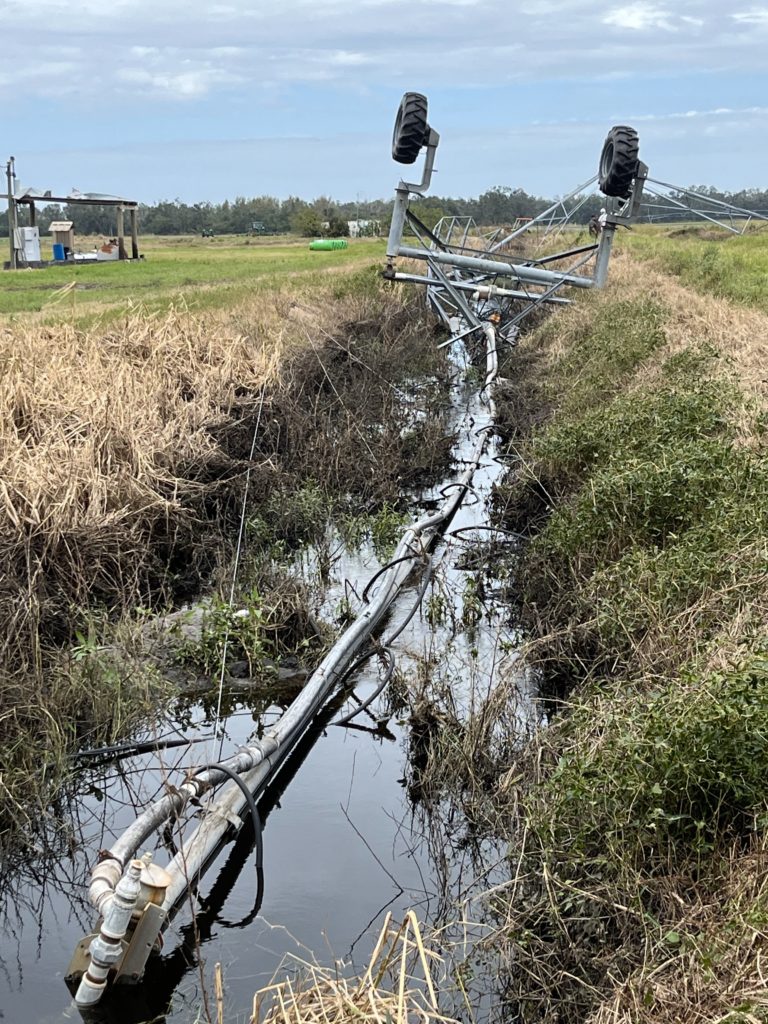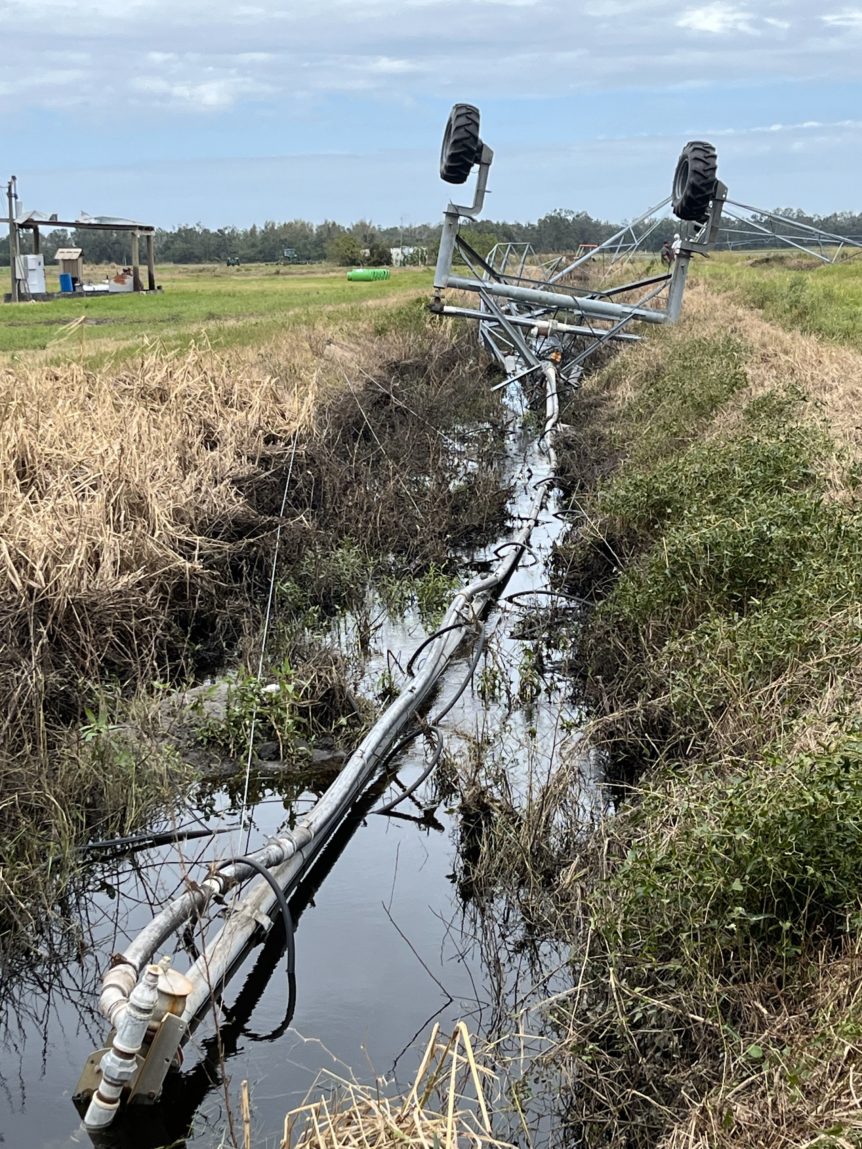
Photos by Sue Harrell
By Clint Thompson and Frank Giles
The fall of 2024 will not soon be forgotten by specialty crop growers in the Southeast after Hurricanes Helene and Milton roared ashore bringing far-reaching impacts to crops and infrastructure. While the true fallout of the storms will take months to realize, early reports show the level of damage growers are dealing with in the Southeast.
Hurricane Helene

Photo by Alan Jones
Hurricane Helene devastated agriculture with its trek through the region on Sept. 26 and 27. High winds and excessive rains especially impacted farmers in southeastern Georgia and the Carolinas.
The preliminary estimate for the economic impact to Georgia agriculture is $6.46 billion, according to the University of Georgia (UGA) College of Agricultural and Environmental Sciences.
“It’s important to ensure that all Georgians understand the impact this storm had, particularly on our state’s No. 1 industry,” Georgia Ag Commissioner Tyler Harper said. “The impact of this storm on agriculture impacts every Georgian whether they realize it or not. We’re talking significant impacts to agriculture; almost $3.2 billion between agriculture and forestry in losses.”
Pecans Pounded
Georgia’s specialty crops were especially impacted, maybe none more than pecans. UGA announced a $138 million impact to the pecan industry. It includes $62 million in crop loss and $76 million in replanting costs. It is estimated that 420,000 trees were lost in the storm.
“We’re still looking at the possibility of more losses with whatever nuts are left in the trees. We don’t know what kind of shape they’re in,” said Lenny Wells, UGA Extension pecan specialist. “The shucks got bruised and beaten by the wind. Usually when that happens, some of those nuts might not make it. Some of those that do, quality may be pretty bad. It’s just hard to say what the extent is.”
Blueberries Blasted
Georgia’s blueberry industry suffered a $52 million impact. There is an expected $150 million impact, however, to future quality loss.
“We’ve suffered a tremendous amount of damage to our blueberries and timber as well. We’re hauling blueberries out by the dump truck load. We were already suffering from so much rain,” said Russ Goodman, a Georgia blueberry grower and state representative, who estimated next year’s production will only net about 40%. “These blueberry bushes have already been through two hurricanes and a tropical storm. I just don’t know how much more they’re going to take.”
Vegetable and Citrus Losses
Georgia vegetables suffered between a $100 million and $120 million loss. About 40% of the state’s $1.2 billion industry is produced in the fall, and there is an estimated 40% loss. The citrus industry had a 40% loss, amounting to $12 million.
Apples and More Impacted
The western regions of South Carolina and North Carolina were mostly impacted by major flooding. Catastrophic rainfall amounts led to widespread flooding in the western part of the state. Elena Rogers, N.C. State Extension area specialized agent in food safety for fresh produce, discussed the damage that the excessive rains have caused to specialty crops.
“It’s definitely a real concern. We’re probably right now at the height of apple harvests. We still have quite a bit of tomato harvests, peppers and mixed vegetables,” Rogers said. “We have a lot of streams, creeks and rivers. Flooding is such an issue. For some of the region, the crops have completely been destroyed.
“Apple trees have been uprooted where you can’t even find the trees. There are areas where damage is significant, and then there are other areas where, thank goodness, there was a significant amount of rainfall, but farms were not close to a creek or a river. Those farms were on a little higher ground. We have both scenarios within the region.”
Hurricane Milton
On Oct. 9, Hurricane Milton made landfall near Siesta Key, Florida, and spread high winds and flooding rains across the state. Key specialty crop regions were impacted by the storm.
Berries a Mixed Bag
Ryan Atwood grows strawberries in Orange County and has blueberry farms across Central Florida. He reports mixed damage to fields based on location.
“On our strawberry planting, we are going to replace about 35% of the plastic on the bed. We had planted about 25% of the strawberry crop, which came through the storm fine.”
In Plant City, the heart of Florida strawberry production, the storm had significant impacts on some farms. There was flooding, and plastic was blown off beds and will need repair.
“On our blueberries, I am seeing about 2% mortality rate of plants so far. We’ll be staking about 5% of the plants. I have some concerns about how the plants will be set up for mechanical harvest this season.
Atwood added a few of his fields had some standing water issues, and most locations had damage to infrastructure like pole barns.
“It’s going to take a lot of work and dollars to clean up,” he said.
Doug Phillips, University of Florida Institute of Food and Agricultural Sciences (UF/IFAS) blueberry Extension coordinator, talked with a handful of producers immediately following Milton.
It’s not as bad as Hurricane Ian from the growers that I’ve heard back from. There is wind damage with plants blown over. There’s some defoliation and wind burn,” Phillips said. “Some of the farms, depending on how wet they typically get, have some standing water they’re pumping out. It doesn’t sound like anything catastrophic.”
Vegetable and Structural Damage
Tony DiMare, president of DiMare Fresh, said tomatoes planted in the Ruskin areas suffered significant damage.
“We will harvest product in the Ruskin area. In fact, we will harvest our first grape tomatoes, starting in mid-October,” DiMare said a few days after Milton. “Round and Roma tomato production will begin toward the end of October with light volume. The volume will remain a little sporadic for the first several weeks until we get into plantings that weren’t impacted as much from Hurricane Milton.”
Alan Jones, owner of Jones Potato Farm, said most of his green bean crop in the Parrish, Florida, area was completely lost. Irrigation pivots were blown over, a barn lost a roof, and personal property was damaged by flooding. He added that his employees were impacted by damaged property as well.
UF/IFAS is conducting a survey of Hurricane Milton and Helene economic impacts on Florida agriculture. The figures will be released as soon as surveys are completed, and data is tabulated.










